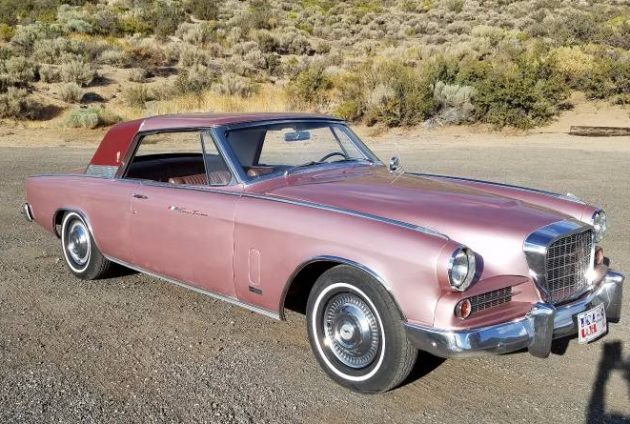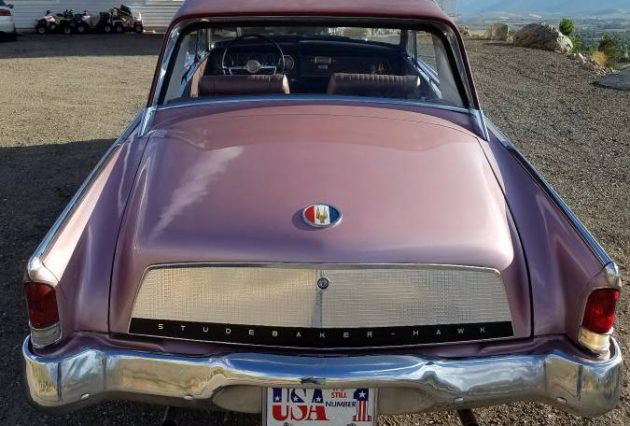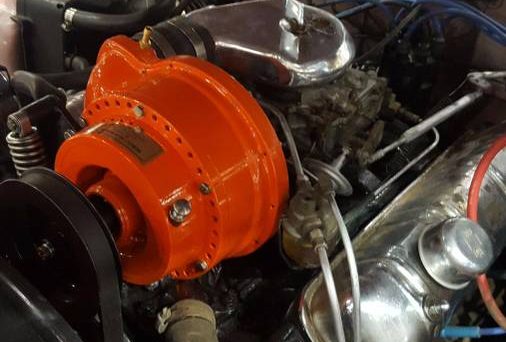Long before the ’90s, when bolting a belt-driven supercharger to your 5.0 Mustang catapulted you to the status of neighborhood Car God, American auto makers experimented with superchargers, including the one in this 1963 Studebaker GT Hawk R2. Thanks to Rocco B. who spotted this apparently well-kept example here on craigslist in Sacramento, California.
The Gran Turismo Hawk, or “GT Hawk,” emerged in 1962 as a redesign of other Studebaker Hawks dating back to the futuristic (and therefore fortuitous) 1953 Starliner. The more formal rear roof treatment (cast in fiberglass) stands out as the GT Hawk’s most unique new design element.
This rather European-looking dashboard houses a host of gauges, and echoes the two-tone exterior, recently repainted in the correct Rose Mist hue, according to the seller. Studebaker took a four-speed GT Hawk to Bonneville and hit 140 MPH on the fabled salt.
Looking rather like the Paxton supercharger on your neighbor’s Fox-body Mustang, this factory-supplied Paxton centrifugal unit is belt-driven and forces air into the carburetor (like a turbo), as opposed to Roots-type blowers that pull air through the carb. Studebaker borrowed the R2 (supercharged) “Jet-Thrust” powerplant from its fiberglass-bodied Avanti sports coupe, and it chops a full four seconds off the non-supercharged car’s 0-60 time. In an era when drag-racers would sell their first-born child for a tenth in the quarter-mile, this blower gets the job done. With few visible differences from non-supercharged models, this “Studey” qualifies as a bonafide sleeper. What do you think of the $24,000 asking price?










A similar car to this was sold today at Mecum Monterey for $44,000.
I had one. Stylish with European elegance but sitting a led sled type chassis originally designed in the early 50s. Going straight fun! Throw it into a higher speed turn and you take your life in hands. 4 speed is the only way to go. They are finally appreciating in value. Still a lot of bang for your buck.
Poor to horrible handling was endemic to all american cars in the sixties, including the muscle cars. They’re great in a straight line, but don’t try to do anything else. As you say, you take your life in your hands. I don’t understand the craze for muscle cars. You throw a huge engine in a stone age chassis, and now they go for six figures.
I sometimes wonder how Studebakers would look today if they could have continued. They had some amazing models.
In Comedians and cars getting coffee (season 8 episode 3 with J.B Smoove) they drive a ‘ 64 Avanti, the interior is one of the nicest I have ever seen in a car.
I like the shade of pink on this GT Hawk, beautiful car. :)
Todd
Are you saying the roof is fiberglass? It is metal like the rest of the car. 24,000 is cheap for one of these if it is as nice as it looks. Our chapter is holding a raffle for one with a R1 four speed. See our website sdckeystonregion.com.
Hi Vince, I believe Todd is referring to is the half vinyl top called the “Sports Roof”. I read, it was only available in ’64. Can’t find much else on it, except the only colors were white and black. Brooks wanted the front portion, which might be fiberglass, to be silver, but ended up being painted the color of the car. I think this half top was added later. This color was dropped for ’64.
Howard
You are right. Also this top does not cover as much as the stock position does.
Hi Vince – I don’t know these cars well, and my fiberglass reference came from the Hagerty article linked above where it says “a Thunderbird-inspired roofline (made of fiberglass to save tooling costs).” You may well be right. Thanks!
Again, this shows how incorrect Classic Car Experts, like Haggarty’s really invent things, and make myths. There is nothing Fiberglass about the Hawks roof. How somebody could invent something out of whole cloth is beyond me? The sports roof has a vinyl cover, but the last time I checked, vinyl and fiberglass were to different things. Thanks a lot Haggarty, you’ve given every Hawk owner another myth to correct…and btw, these R2’s sell for 40 to 60 grand regularly, this price is ridiculously low.
…And I thought the sports roofs were vinyl on the front half of the roof, not the back half. I’m not liking this roof treatment, but the rest of the car looks nice. Asking price is very reasonable for an original R2 car.
Wow! My late brother had bought a 63 Hawk R2 in the late 70’s for $300. It had a hurst 4-speed in it, the Paxton supercharger was still in place but seized. I don’t know what the original color was, but it had been painted black and had a turquoise interior. Car had a lot of rust, tops of the fenders, truck bottom, etc.. Car ran well, but needed a master cylinder, so just sat till he sold it for $700 and was really happy to get that.
He also owned a 1964 Hawk GT, white on white. His best friend still owns that, a low mileage car.
One of my favorite cars. The color, while a factory color, is a bit loud, but at least it’s not black or silver. The thing about these cars, is most, almost always have the supercharger. It’s almost it’s “claim to fame”, and I don’t care for that. We don’t drive around on Bonneville Salt Flats all day. (although, some highways do resemble that) These cars had so much more to offer the lucky driver that had one. I’d think that would load up in daily usage. I’d think it’s just for the “wow” factor today, and I’d be perfectly happy with a 2 barrel, and cruise along in one of the coolest cars made. This a very nice car,,,sans the “puffer”.
The Sports Roof would have been on the front part of the roof.
Comments confirmed what I suspected, this seems to be a great price, for a very “cool car”.
Styling way before its time. My cousin had a black ’56 Golden Hawk with a reworked engine. He ate all the Ford and Chevy’s of the era.
This car is a bargain.
When I was much younger, we used to go to Vail in the Summer. There was a pearl white Golden Hawk that was often parked up by the north lift station. It was an amazing car. There were other “fancy” cars around there, but the Golden Hawk drew the most interest. If I’m not incorrect, I believe it was a Raymond Loewy design. Easily the match for some of the European offerings of the era. It would be nice to see this one become a 10 10ths car, but it would be done for love, the money would never come. Nice car.
And, they were surprisingly well made in terms of the detail of the interior compared to a Big 3 of the time. My Chevy had exposed screw heads all over the place, cardboard panels on the inside of the doors, a cardboard ledge behind the back seat, cardboard between the back seat and the trunk, the seat fabric (some kind of woven plastic) was toast at 40,000 miles. The color of this one is not my style, but to each his own.
A search of auction results shows a range of prices $23,000-$35,000, depending on condition. Need to know the mileage. At less than 50,000 miles, its a bargain.
More than 100,000 miles, its the right price.
The ad states clearly that it is 88,000 miles. The color was the same color Rambler used as my first car was a Rambler in this color only it was called Calias Coral and was a metalic paint. Although both of the paint colors were less pinkish with more of a bronze tone than any car I have seen today painted in that color. Even when I had my ’63 Rambler repainted with supposedly the same color it was more on the pink side than original comparing the color of the unrepainted door jambs. If it is in as good a condition as it looks it is a bargain in my opinion.
There was one at the Hackenburger sale in Norwalk Ohio. It was in great shape and all complete, gold in color. Sold for 22.000. Another one went for 18.000.
GP
Those prices are about right for a GT but a steal if they were R2s.
Vince H, They were both R2s. You should be able to look it up in the past auctions and see pictures. I also know of another one about 20 miles from me, Came from California in 1974. Not in good shape and still not for sale.
Howard – take a break .
From what? What did I say that shook up YOUR soda?
that’s a bit of a generalization. I”m not sure that it’s even remotely correct. Midsized cars from Chrysler, Ford and GM all had handling packages even the Pony cars. They may not have been as agile as a MG or Triumph, but they had good handling characteristics. The above Studebaker was running on 1950’s technology and was never designed to be a handling car. Take any Police Pursuit vehicle built in the mid 60s, a Belvedere or even a Studebaker Pursuit Marshal and you’ll find they can handle very well.
Very true Frank. When I was in high school, I had a ’48 Dodge Business Coupe. I found it road wonderfully on dirt roads. Compared to the small agile European cars, it was a big old dinosaur. But for the roads that were prevalent when it was built, it was more than competent. Even the full size police cars like the Plymouth Fury were decent handling cars. Was there room to improve? Yes. Off the showroom floor, they had their pluses.
Would love to own and drive this. Pretty car!